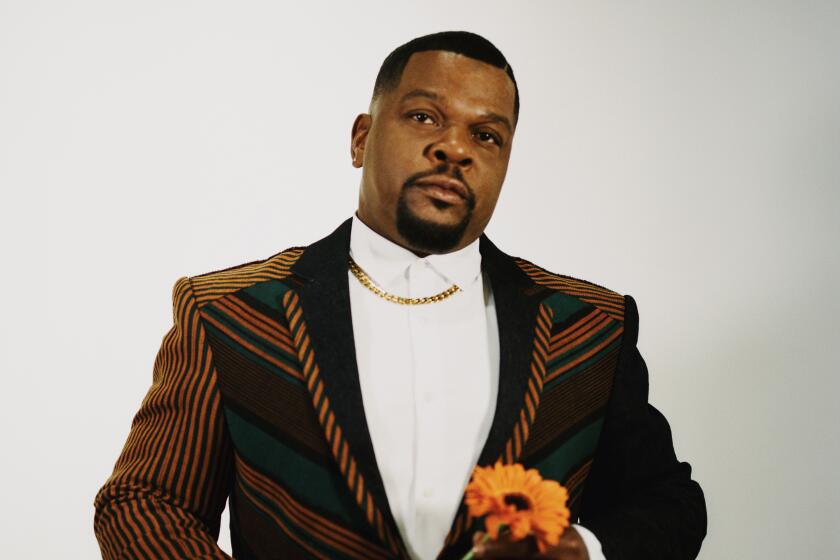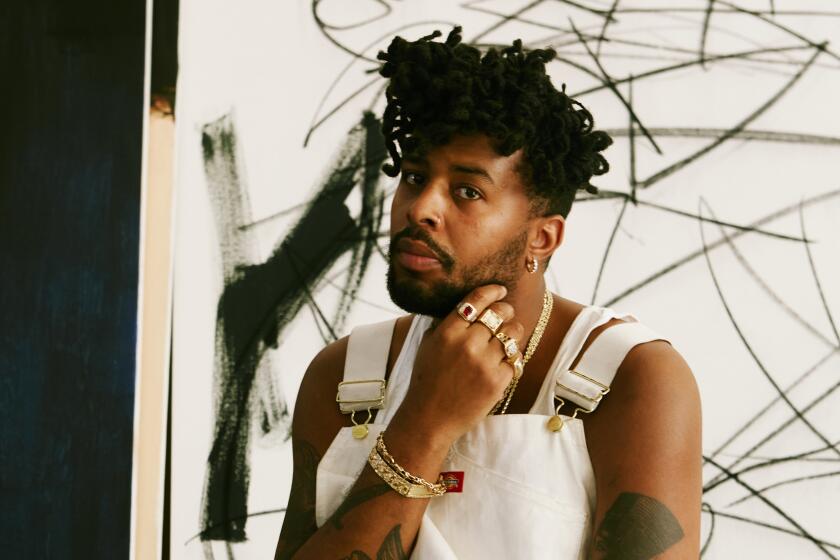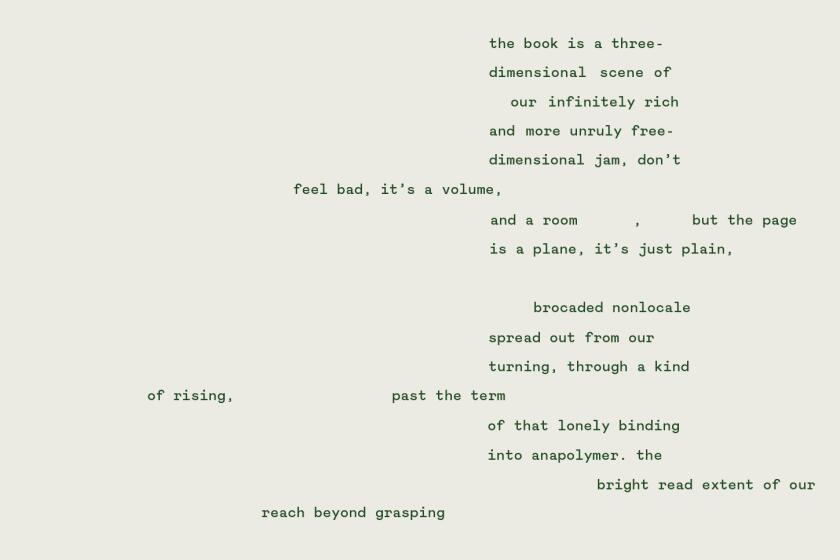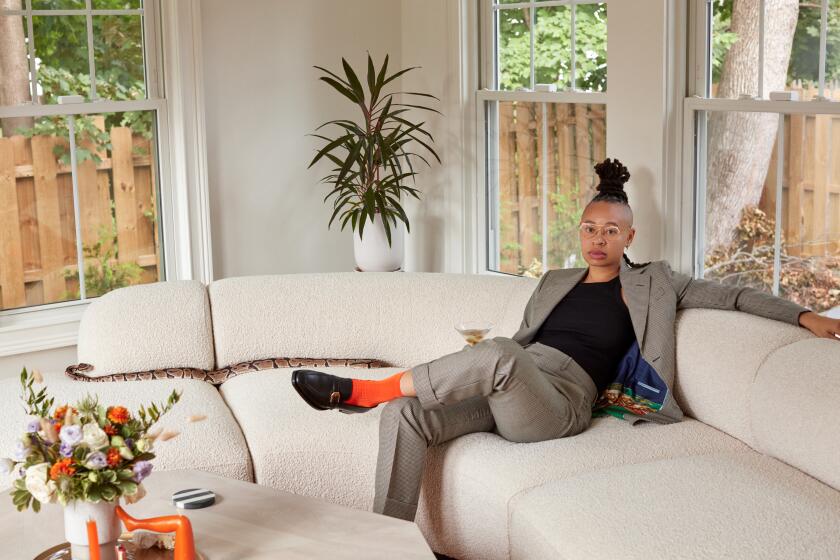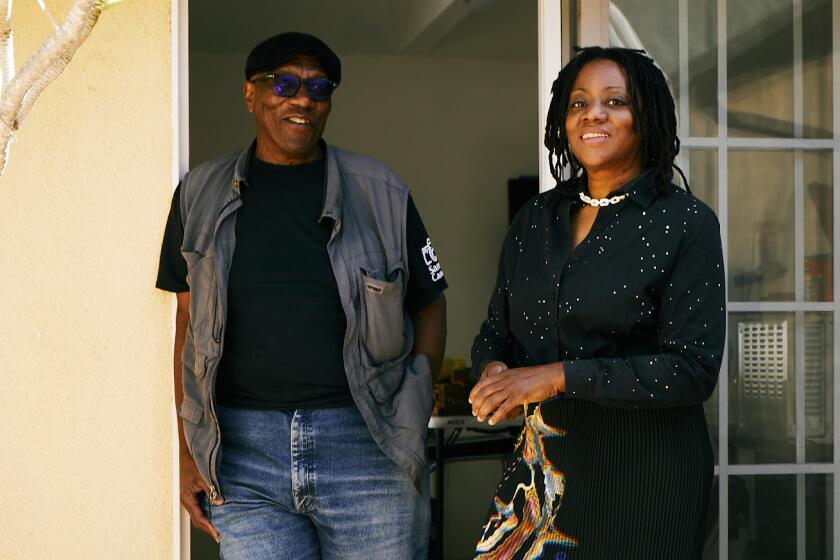- Share via
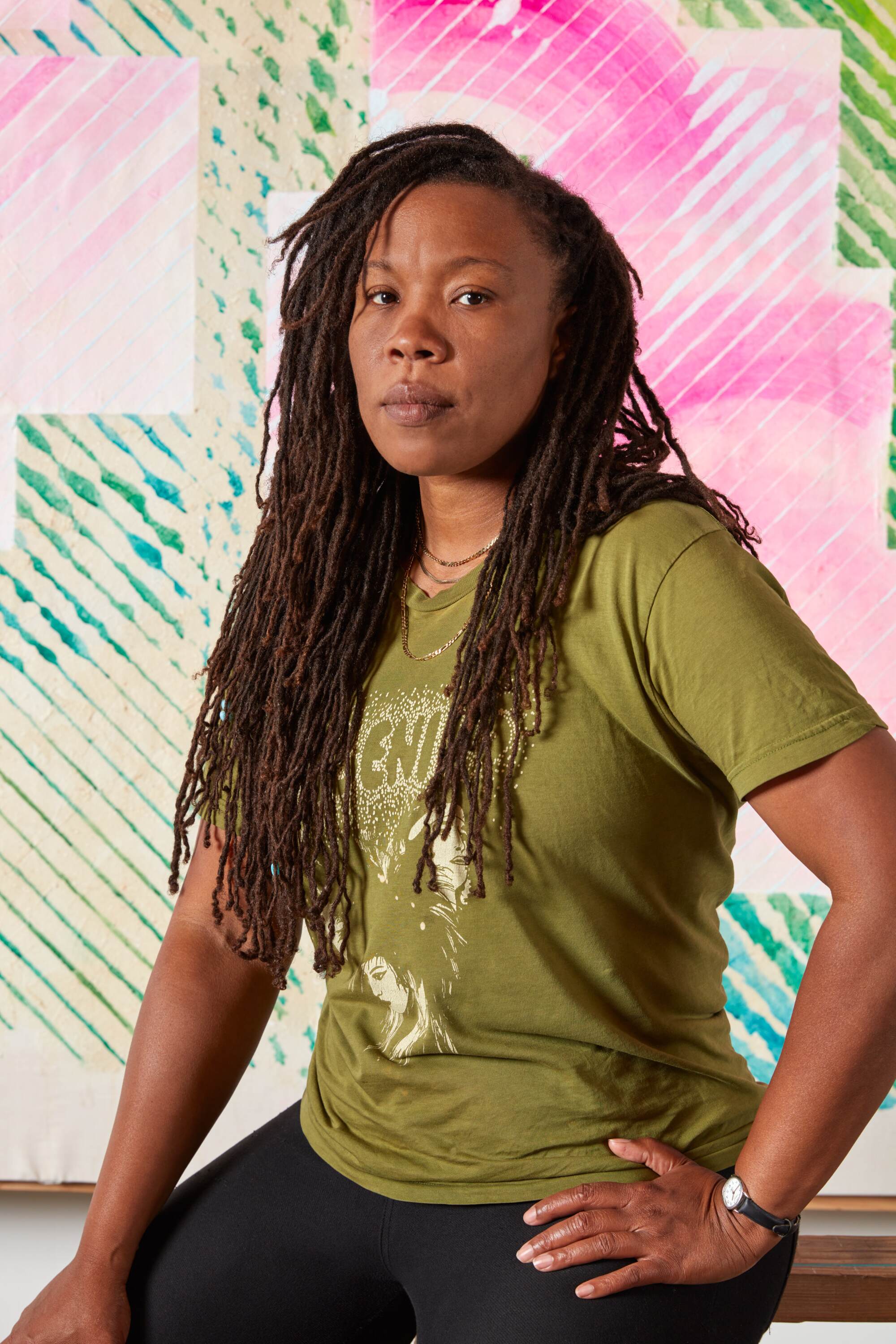
Tomashi Jackson is beloved. She joked during our Zoom call that I had good juju. A dear artist friend had texted her out of the blue; Jackson teased that it must have been my charm. I think it’s the other way around. Jackson exudes an aura that flits with a kaleidoscopic exuberance. She glimmers and radiantly smiles at weighted moments in our chat, and then dips into vulnerable tenors when the time feels apt. We laughed at the slips of tongue that made space for memories of Midtown Lanes and cul-de-sacs off the 10. She knew the crossroads of Seventh and Washington as home, forgetting the specific perpendicular street that housed the stories she now imagines. But that’s memory — it urges Jackson into metaphorical head spaces, where color, confusion and clarity hold equal footing.
Jackson may not live in Los Angeles anymore, but her memories of these dead-end streets provided a surprising inroad into how intimacy is still a very abstract construct. And abstract not in the withholding sense. Rather, my time with Jackson illumined a generative confusion to how she understood abstraction in art and life.
Jackson went to Immaculate Heart and Los Angeles County High School for the Arts, taking in the colorful murals across the city in the ’90s and immersing herself in art history books. All these commutes take on double meaning for Jackson. Her mother, Aver Marie Burroughs, would drive around to construction sites throughout Los Angeles with Jackson in tow, the two listening to soft rock or New Jack R&B. One of those cherished jaunts inspired Jackson’s solo exhibition opening this weekend at Night Gallery, “Minute by Minute.”
With the help of his mother, Ms. Freddie Mae Wiley, L.A.’s native son is on the search for a radical freedom divorced from fixed Western notions of race, gender and class.
The Doobie Brothers CD was a memento Jackson’s mother gave her when she left Los Angeles for college. Jackson’s mother is now dead. When Burroughs passed away, Jackson wasn’t physically there with her due to COVID restrictions on travel. Instead, what her mother left were photographs of trees. Made a few months before her death, these tree studies index Burroughs’ nuanced kinship with isolation and death. It’s as if she accepted her lot and decided, like Baby Suggs in “Beloved,” that she needs “to think about the colors of things ... [that are] harmless in this world.” That these things were the boughs and leaves of trees reiterates that the end of life is a time where we self-prune, expand our eyes and forgo the things that don’t serve us.
If you look close enough at “Sweet Feelin’” (2023), you’ll see the eye of a tree held in this blue-black entanglement of halftone lines. In the right corner, two men embrace, the parchment tone distinct from the blueish, gridded expanse that spreads out from the center of the canvas, framing the edges just so. One could read the grid arrangement as a quilt design. But I’m drawn toward a redlining map. Why? Jackson’s family experienced years of dispossession at the hands of eminent domain rulings and gentrification. Her mother landed in Bakersfield — a place unfamiliar to Jackson — after being priced out of Los Angeles. To sit with this violence reveals why Fred Moten sees “blue is already in green.” As I move through “Minute by Minute,” I like to think of these tree studies Jackson’s mother took before her death as planting the seeds of a narrative yet to be imagined. Thankfully, Jackson’s exhibition begins that work of imagining.

Ikechúkwú Onyewuenyi: Although this is one of many Los Angeles homecomings, I imagine this one lands a bit differently given the death of your mother during the COVID pandemic and the deeply personal body of work you’ve made following that experience in this exhibition. How has coming home landed for you recently?
Tomashi Jackson: I was horrified when I last came home and saw the catastrophic destruction that is happening to the Black and brown community. Areas like Crenshaw were never food or cultural deserts. Redevelopment entities have come in and decided that we’re not needed, and we don’t need a grocery store. When Ralphs on Western Avenue and Martin Luther King Jr. Boulevard closed in the middle of the pandemic I couldn’t eat for days. It’s such war-like behavior to do that to people in the middle of a lockdown. I can tell you from growing up there, with all the things that we went through in the ’80s and ’90s, that Crenshaw Boulevard has never been a food desert.
Honesty is what makes the L.A.-based artist’s multifaceted works felt: “If I paint something and it makes me sad, it’s f—ing sad. That is the barometer of the life of the piece, so to speak.”
IO: The accumulation via dispossession continues to mark this area of Los Angeles, which, in a way, was an autonomous Black community. I’m drawn to how your work visualizes not only this dispossession but the informal, affective narratives that can’t be taken away or possessed.
TJ: It wasn’t until “Land Claim,” my solo exhibition at the Parrish Art Museum [in 2021], that the research methodology underlying my artistic practice became apparent. It goes back to when I studied at Massachusetts Institute of Technology in the School of Architecture. For “Land Claim,” I was adamant that the images and paintings for that exhibition wouldn’t exist without the voices and conversations I had with the Indigenous, Black and Latinx families on the eastern end of Long Island — i.e., Shinnecock Nation — who have seen their land illegally possessed. From “Land Claim” to my MIT thesis to “Minute by Minute,” I’ve been employing a research methodology that considers participatory inquiry, which allows me to investigate stories of informal labor economies transforming the built environment. There’s a focus on Black women, Black women of color, particularly Black women domestic laborers whose (silent) presence allows the wheels of the formal economy to function. Their work is without social protection or security, riddled with fear of the punitive response from the state. Meanwhile, their employers get to enjoy the avoidance of taxation by paying them under the table. This lived experience mirrored mine; I was a nanny, babysitter and cook while I deferred my studies at Cooper Union.
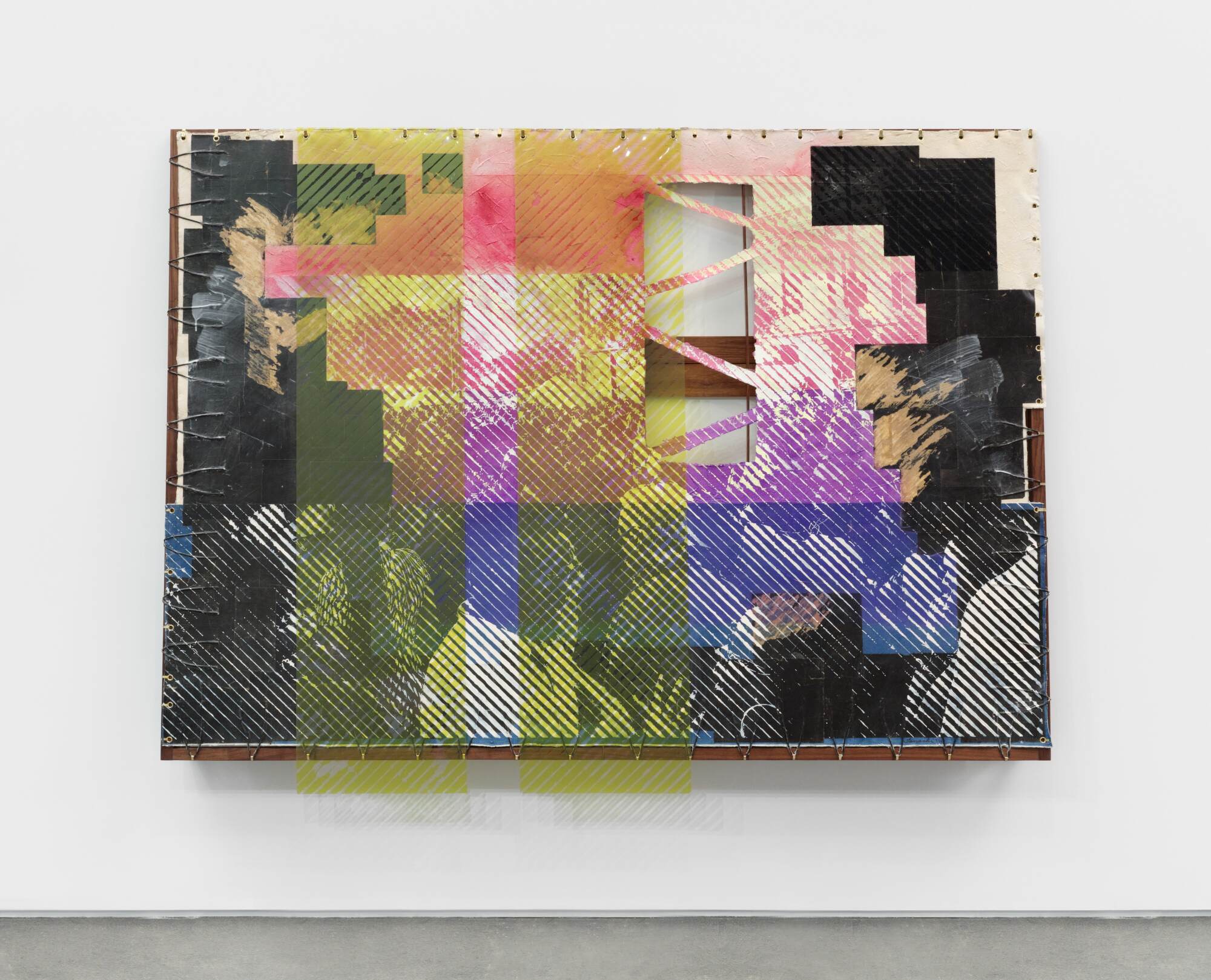
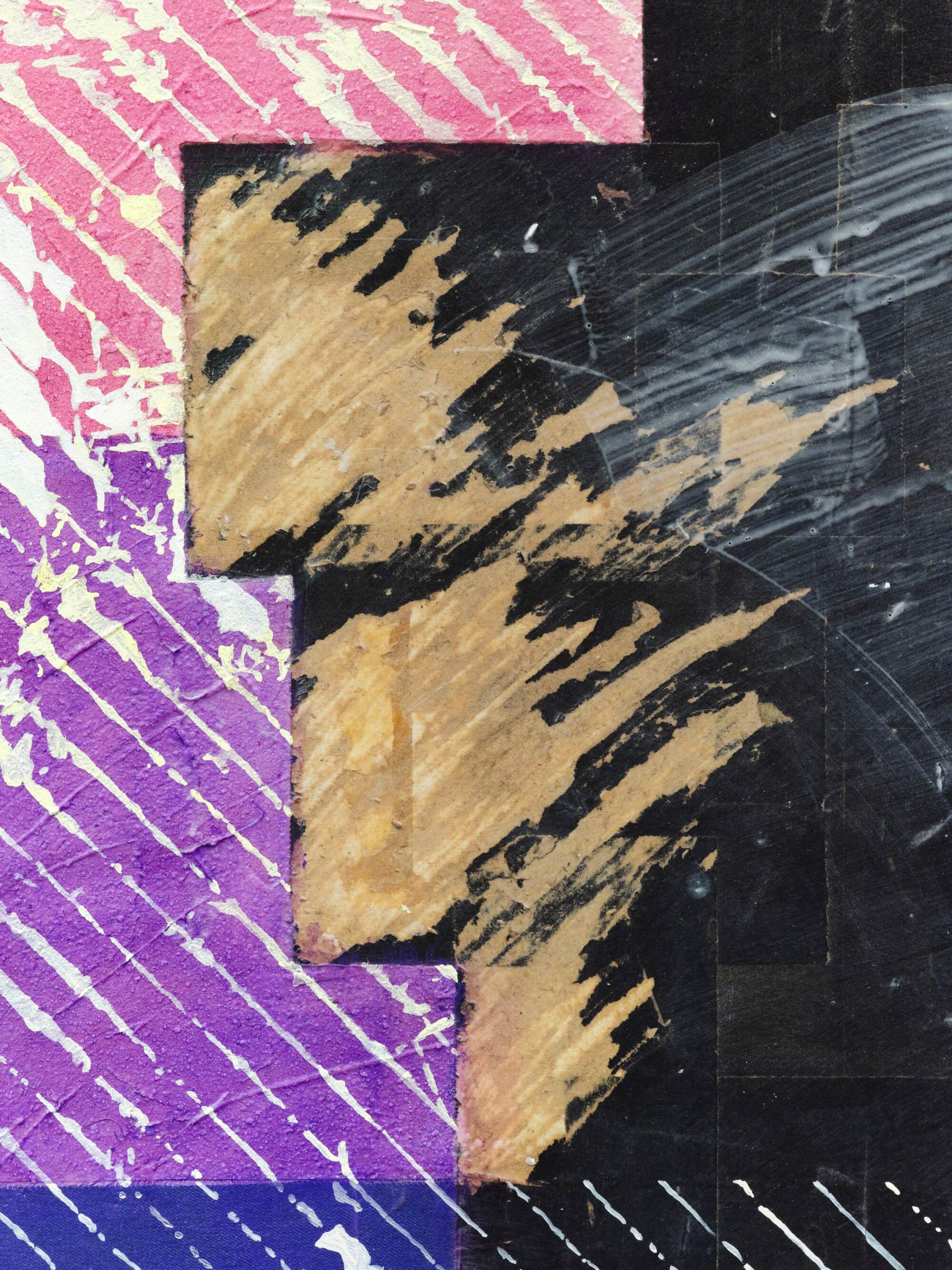
IO: For some time, my mom cleaned toilets at our church in Sydney while completing her doctoral work. Because of that history, I always return to Cherríe Moraga’s 1983 poem “Half-Breed.” This sense of invisible laboring workers interfacing with infrastructure calls to mind Moraga’s ambiguous play on words that sets up the white porcelain toilet bowl as a site where struggles over color start festering across generations. Could you talk a bit about what you’ve described as a “struggle with color” and “confusion about color” and how those elementary school feelings track into your later artistic practice?
TJ: My understanding of art in the world was first established by the presence of paintings in the built environment because I grew up in Los Angeles, which had hosted two Summer Olympics. Back then, preparing the city for the Olympics was about building a stadium, painting murals, which was very much in the Southern California Chicano arts tradition. When I was learning how to see or where I was in the city, it was really defined by paintings. It was defined by Roderick Sykes, and Noni Olabisi, and Kent Twitchell. There’s also Juana Alicia and Susan Cervantes — the women who painted the Women’s Building in San Francisco took me under their wing. They taught me how to climb scaffolding and paint murals when I dropped out of SFAI [San Francisco Art Institute]. I left to be an apprentice, the same way that my mother was an engineer’s apprentice. So, I come from a world of color. I come from Los Angeles, San Francisco, Oakland.
To the “confusion,” I remember taking art history classes in high school and seeing Color Field and AbEx [Abstract Expressionist] paintings in our books, but they were black-and-white thumbnail pictures. I couldn’t really understand the physicality of the paintings and why these squares were such a big deal. When I got to New York and was sent to museums by my teachers, I had my own physical experience with these large-scale paintings, like Ad Reinhardt, Barnett Newman, Alma Thomas, Jack Whitten. It was a transformative experience of color, of seeing.
In an excerpt of the poem ‘the red sheaves’ from his forthcoming collection, ‘perennial fashion presence falling,’ the multihyphenate artist gives a sneak peek of an infinitely rich and more unruly freedom jam.
I complemented this seeing by zeroing in on acts of labor in public space in New York City. Where I was in the city and what I saw there let me know what time it was. For example, I knew what time it was by how many Black women I saw in a park acting as nannies. Come 8, 9 or 10 o’clock at night, these Black women were all gone. Come 8 o’clock in the morning, they’re all back. I started to ask questions of people like Dore Ashton, my art history professor at Cooper Union, and the brothers and sisters who were security guards at the school. Mr. Mac, for instance, was a police officer in Guyana but worked as a security guard in the U.S. Through these stories, I became very interested in these narratives of migration and visualizing them. How does migration visualize itself through our bodies in public space? I’m still thinking like a Southern Californian, with color and art animating public space — but what are the labor implications? From this, I started to see my people’s narratives because my people are domestic workers from Texas and, once in California, they never talked about this migration because people generally don’t talk.
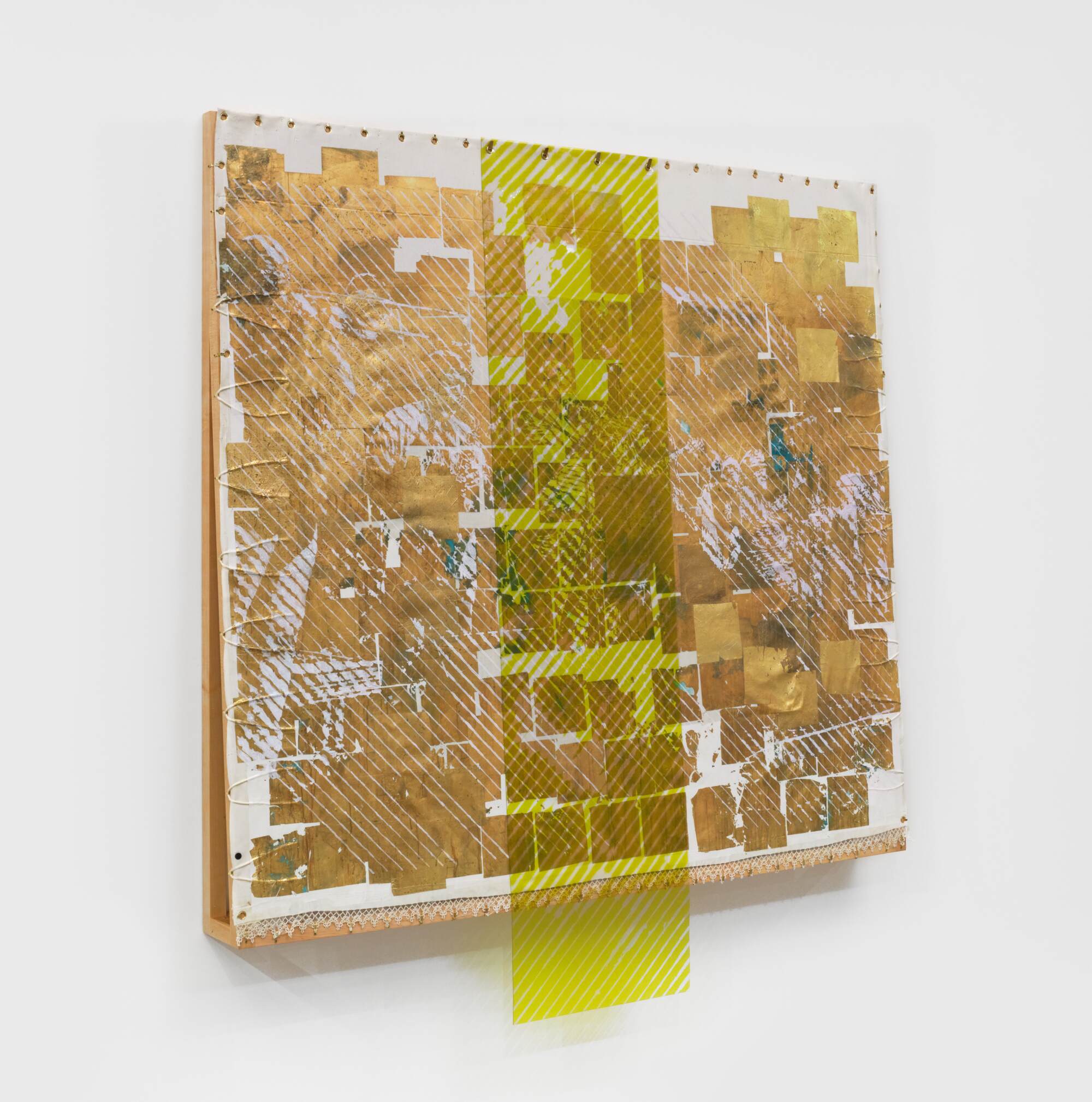
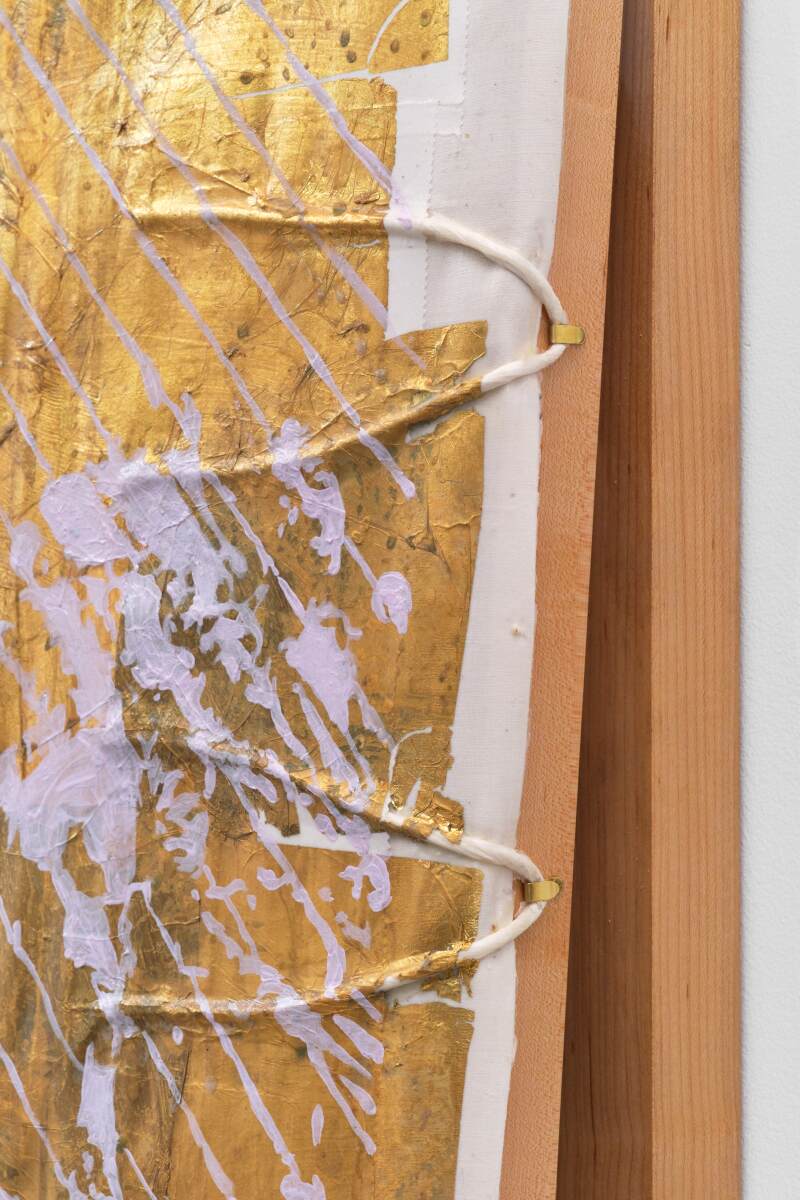

IO: You’re an artist who studied architecture at MIT and took classes on economic theory. It really speaks to your interdisciplinary approach to art making.
TJ: Art got me to economics. At Harvard Kennedy School I took a class with Martha Chen, who specializes in how informal labor markets operate in any city. And then I started seeing, very clearly, my family’s unspoken narrative. I saw my great-aunts donning these uniforms and driving out to Orange County or Laurel Canyon in order to cook and clean for people. I started interviewing my mother around 10 years ago about this family history.
IO: This reminds me of Chantal Akerman’s last film, “No Home Movie,” in which she spends her mother’s last months interviewing her over Skype.
TJ: My mother was the oldest of my grandmother’s nine children, so she was the one who went to work with my great-aunts when they were domestics. We had these conversations — not enough, unfortunately — about our family’s relationship to labor and land spanning from Texas to California. We talked about what it was like going to work with them in the ’50s and ’60s, cleaning and cooking for very, very wealthy white people, British people, actors, oil families. At one point, my great-aunt was the master pastry chef at the Monastery [of the Angels] in Laurel Canyon. I didn’t even know it existed. The story goes that my grandmother and her sisters escaped Texas by supposedly hopping trains.
Artist Sable Elyse Smith draws on the sights and sounds and language of the carnival and the prison, revealing how deeply intertwined punishment is with entertainment and spectacle.
IO: There’s a fitting observation about this movement from Joan Didion in her 2006 Paris Review interview when she said, “I had a theory that if I could understand the South, I would understand something about California, because a lot of the California settlers came from the Border South.”
TJ: Well, working as domestics, my grandmother and her sisters owned their houses once they got to Los Angeles. But it was the livelihood migration from the South that gave them a footing here in Los Angeles. My Aunt Jackie owned a huge house the size of a ranch in Los Angeles. I recall seeing pictures of the house. I just learned in early July 2023 when I came home that the house was taken by eminent domain for the 105 Freeway, and she was given like $5,000. This ranch-style home had chickens, a garden, and the kitchen was as big as two living rooms. The house that I grew up visiting Aunt Jackie was in South-Central, which was her second house after the loss of the first house. It was what she could afford after the city took this palatial home that we had. There’s just been a lot of loss, and my people just didn’t really talk about a lot of these things. I think talking about it unearthed too much pain. I remember as a child wanting to ask more questions and being told to stop.
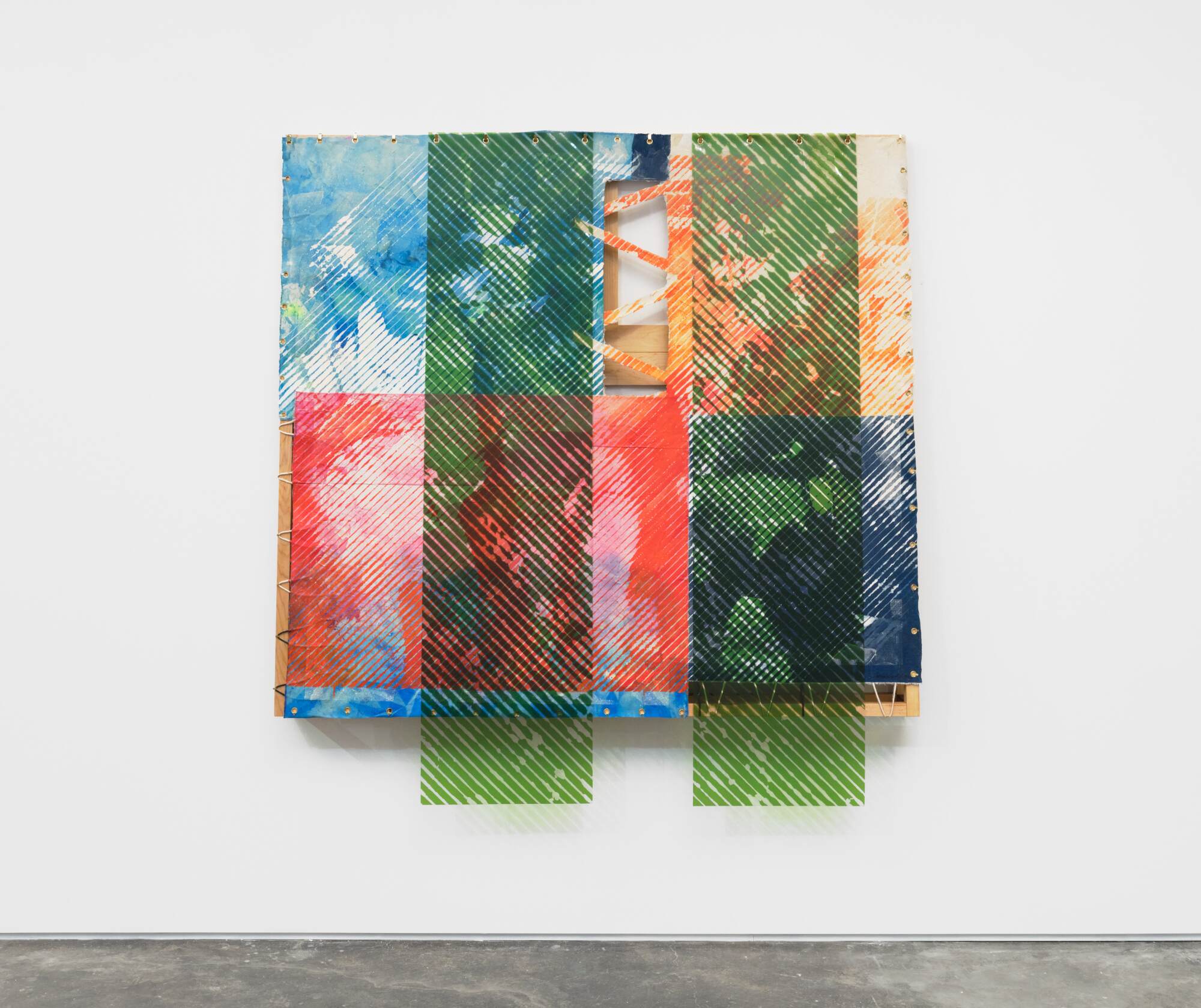
IO: With your mother’s death, I imagine having those recordings stretched the object of analysis.
TJ: It ended up being crucial now because she’s gone. When I realized that she was sick, I immediately tried to get her onto Zoom with me because we had been doing family hangouts on there. She was too sick, though. We found out that she was very sick after Christmas 2020. She was gone by mid-February 2021.
IO: I’m really sorry. How does your mother figure into “Minute by Minute”?
TJ: She was the keeper, a real photographic memory. She knew how I got here from Texas. She knew everything. Alongside the recordings, I now have these pictures she took before she died. This exhibition at Night Gallery is made from the pictures that I sourced from her last camera. She was a photographer, among other things. I don’t know what happened to all her memory cards because I wasn’t there when her apartment was cleaned out. I wasn’t listened to. It was so horrific. But they set aside for me this new camera she owned with a telephoto lens. I finally got it a couple of months ago when I was visiting my gallery and my aunt, who I hadn’t spoken to for three years. After all this heartbreak with how my mom’s affairs were handled, I went into no contact with most of my family. So, yes, to your earlier point, these last few visits to L.A. have been somewhat charged homecomings.
L.A.’s rich cultural history is alive through the life and work of the city’s unofficial poet laureate. Just ask her brother George Evans.
IO: I guess we can think of her photographs as another way to map your family’s migration.
TJ: Yes, through her photography practice, I’m reminded of her varied interests. She took photo and film classes at LACC. She learned refrigeration and air conditioning at L.A. Trade Technical College. I would just go to all these campuses with her growing up. She was an out Black lesbian woman. The first woman, first Black woman, first Black lesbian woman member of the International Union of Operating Engineers. She worked for years at Kaiser Permanente, breaking the ceiling open because other women came after her. Other gay women and other women in general came after her. She worked on construction sites. She was a plumber and electrician. She was brilliant. She was really thought of as a laborer. But what she loved artistically was photography. That’s why I know all those memory cards are somewhere.
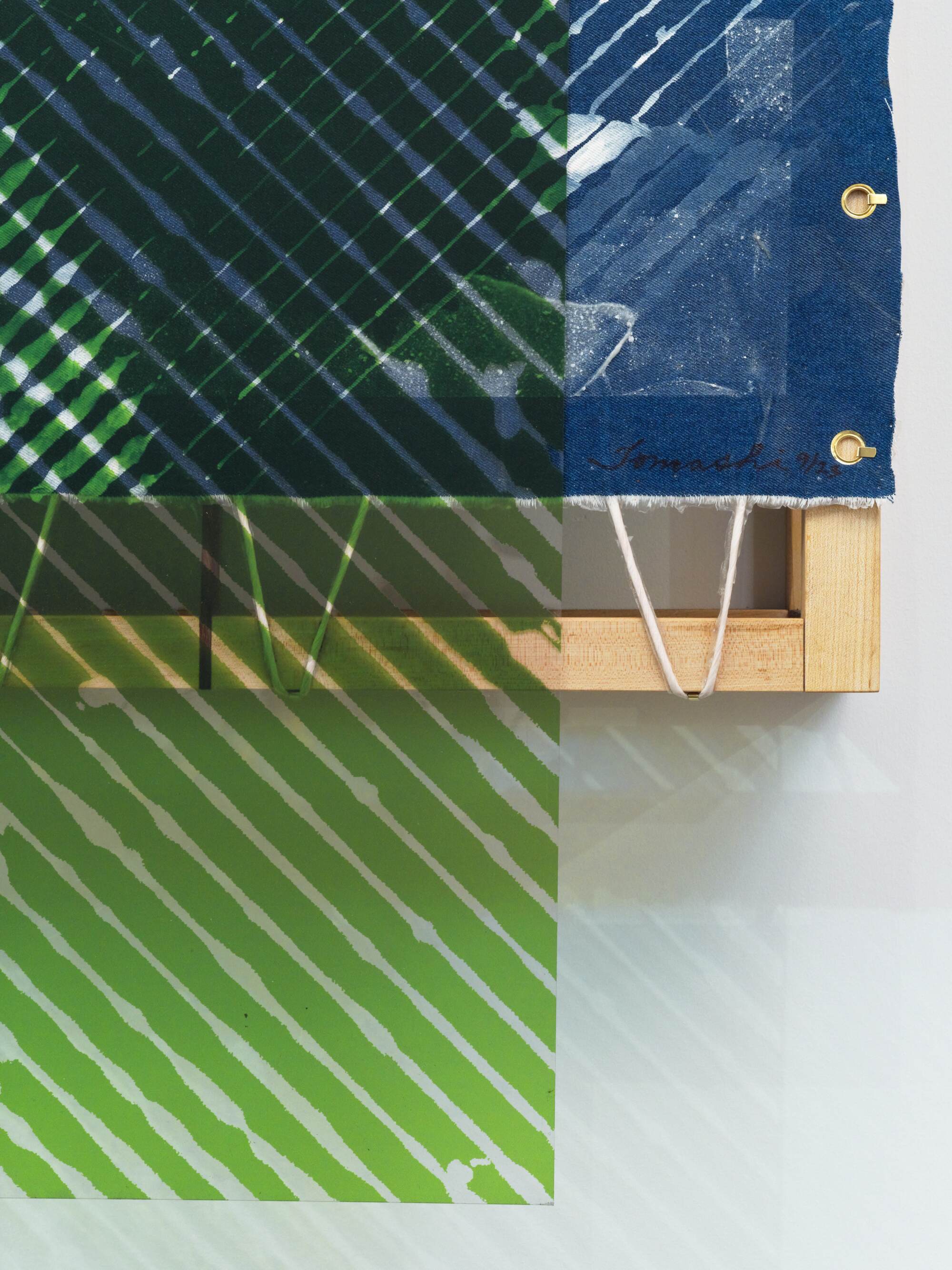
IO: So, these memory cards …
TJ: I didn’t find a whole bunch of memory cards, but in the camera itself, there was one memory card with maybe 10 test images on it, and they’re all studies of trees, and they were all taken on the same day: Dec. 2, 2020, which was a few weeks before we found out that she was really sick, about two months before she died. There’s only so much I can know from these images. She was a brilliant photographer, a student of the medium. The camera was brand-new — it had that new-car smell. And the tree must have been in her backyard in Bakersfield.
IO: These tree studies your mom documented are on par with Toni Morrison’s “Beloved” — as Baby Suggs’ life was ending, she was “pondering color” through requests of “lavender” or “pink” flowers. Her daughter Sethe also “became ... color conscious,” tending to Baby Suggs. It seems “Minute by Minute” is similarly tending to your mother by using her images.
TJ: I’ve been using the halftone line to transform my mother’s images and cause them to intersect and intertwine with my images of moments that I’ve had since coming out of isolation. Her pictures were taken in the loneliness of isolation. My pictures are taken in moments where I’m surprised over and over again to find myself surrounded by people. I became really interested in how people would gather and create spaces for self-determination and joy in spite of what we’ve been through. The images and research in “Minute by Minute” are very dark. What I really wanted to do this time was to collide images of gathering and grief and allow them to crosshatch, intersect, make new colors, make new images.
Ikechúkwú Onyewuenyi is a curator and writer based in Los Angeles. He’s also on the editorial board of X-TRA.
